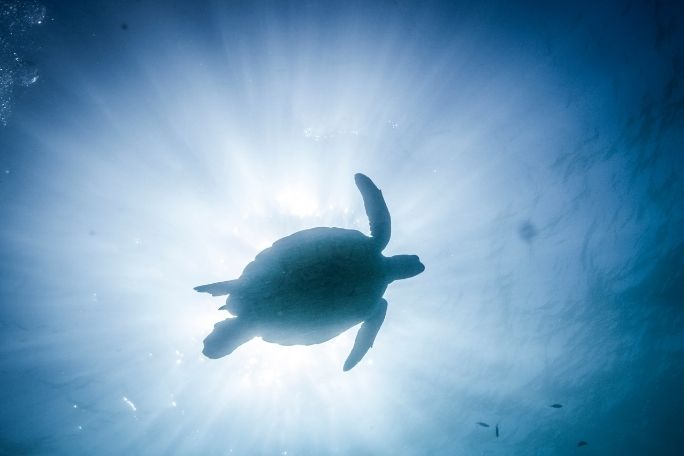Lesson summary
In this social action lesson, students will become ocean guardians by taking action around the issue of plastic in the ocean. They will engage in an abridged version of the design thinking process to create their own turtle-friendly lunchbox. Students will work together to brainstorm ideas, then design their turtle-friendly lunch box that does not contain any throw away plastic. Students will then share this action with their families and encourage them to make change to their own lunch containers.
Learning intentions:
Students will...
- be introduced to social action
- understand that they can contribute to something bigger than themselves.
Success criteria:
Students can...
- show awareness of the throw away plastic in our lunch boxes
- plan plastic free lunches and bring less plastic to school
- connect their action with the role of an ocean guardian.
Lesson guides and printables
Lesson details
Curriculum mapping
Australian curriculum content descriptions:
Foundation HASS:
- Interpret data and information displayed in pictures and texts and on maps (ACHASSI007).
- Draw simple conclusions based on discussions, observations and information displayed in pictures and texts and on maps (ACHASSI008).
- Reflect on learning to propose how to care for places and sites that are important or significant (ACHASSI009).
Year 1 HASS:
- Interpret data and information displayed in pictures and texts and on maps (ACHASSI024).
- Draw simple conclusions based on discussions, observations and information displayed in pictures and texts and on maps (ACHASSI025).
- Reflect on learning to propose how to care for places and sites that are important or significant (ACHASSI026).
Year 2 HASS:
- Interpret data and information displayed in pictures and texts and on maps (ACHASSI040).
- Draw simple conclusions based on discussions, observations and information displayed in pictures and texts and on maps (ACHASSI041).
- Reflect on learning to propose how to care for places and sites that are important or significant (ACHASSI042).
Foundation English:
- Deliver short oral presentations to peers (ACELY1647)
Year 1 English:
- Make short presentations using some introduced text structures and language, for example opening statements (ACELY1657)
Year 2 English:
- Identify the audience of imaginative, informative and persuasive texts (ACELY1668).
General capabilities: Critical and creative thinking
Cross-curriculum priority: Sustainability OI.2, OI.3, OI.6
Relevant parts of Year F-2 achievement standards:
- HASS Foundation: Students reflect on their learning to suggest ways they can care for a familiar place.
- HASS Year 1: Students reflect on their learning to suggest ways they can care for places.
- HASS Year 2: Students reflect on their learning to suggest ways to care for places and sites of significance.
- English Foundation: In informal group and whole class settings, students communicate clearly.
- English Year 1: They create short texts for a small range of purposes.
- English Year 2: They use a variety of strategies to engage in group and class discussions and make presentations.
Unit of work: Blue The Film: Inquiry – Foundation, Blue The Film: Inquiry – Years 1 & 2
Time required: 120 mins.
Level of teacher scaffolding: Medium – lead students in discussion and class activities, oversee group work.
Resources required
- Student Worksheet – one copy per student
- Device capable of presenting a website and video to the class
- A Turtle’s Life presentation
- A3 paper and textas
- Cling wrap, freezer bag, baking paper, small plastic containers, paper straws and bamboo cutlery (examples of wrapping and containers used in lunch boxes could be collected from your colleagues’ lunch boxes)
- Turtle-Friendly Lunchbox template
Skills
This lesson is designed to build students’ competencies in the following skills:
- Communication
- Community Engagement
- Collaboration
- Creativity
- Empathy
- Global Citizenship
- Problem Solving
Additional info
Blue is a feature documentary film charting the drastic decline in the health of our oceans. With more than half of all marine life lost and the expansion of the industrialization of the seas, the film sets out the challenges we are facing and the opportunities for positive change. Blue changes the way we think about our liquid world and inspires the audience to action. Find out how to screen or download the film here. Along with the film is an ambitious global campaign to create advocacy and behaviour change through the #oceanguardian movement. To become an ocean guardian, see the website.


Welcome back!
Don't have an account yet?
Log in with:
By signing up to Cool.org you consent and agree to Cool's privacy policy to
store, manage and process your personal information. To read more, please see
our privacy policy here(Opens in new tab).
Create your free Cool.org account.
Many of our resources are free, with an option to upgrade to Cool+ for premium content.
Already have an account?
Sign up with:
By signing up to Cool.org you consent and agree to Cool's privacy policy to
store, manage and process your personal information. To read more, please see
our privacy policy here(Opens in new tab).